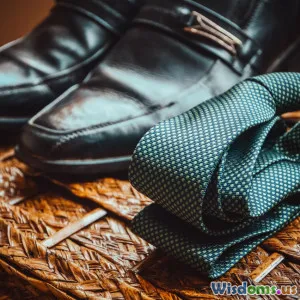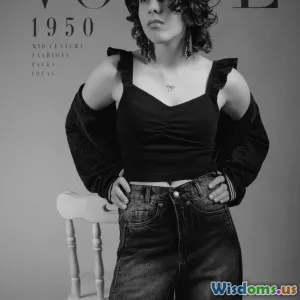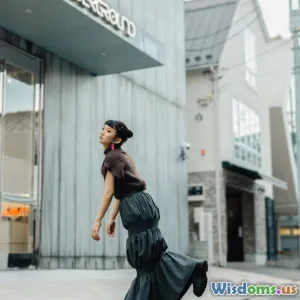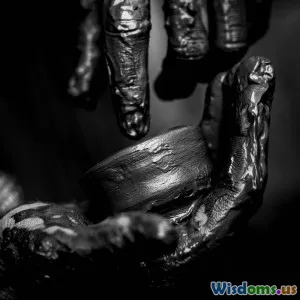
How Layering Can Transform Your Fall Workwear Game Instantly
9 min read Discover how strategic layering elevates your fall workwear for style, comfort, and versatility. (0 Reviews)
How Layering Can Transform Your Fall Workwear Game Instantly
Fall ushers in a season of change—not just in the leaves outside your window, but in your wardrobe as well. When temperatures dip and the workday demands professionalism mixed with comfort, layering emerges as an essential style strategy. But layering isn’t just about putting on more clothes; it’s about mastering an art form that balances warmth, style, and versatility seamlessly.
In this article, we’ll dive deep into how layering can revolutionize your fall workwear, providing insights rooted in style theory, fabric science, and practical example-driven advice. Whether you’re a corporate professional navigating boardrooms or a creative seeking effortless polish, layering can be a game-changer.
Why Layering Matters for Fall Workwear
The Climate Challenge
Fall weather often fluctuates drastically—mornings are crisp and chilly, afternoons may warm up under the sun, and evenings can drop suddenly. According to the National Oceanic and Atmospheric Administration (NOAA), average fall temperatures in many cities vary 15–20°F from dawn to dusk. This swing demands adaptable wardrobes that respond to dynamic conditions.
Layering meets this challenge by enabling you to add or remove clothing elements effortlessly without sacrificing style or professionalism.
Comfort Meets Professionalism
No one wants to be distracted by discomfort during a busy workday. Sweating in a heavy coat then shivering in a thin shirt can undermine your focus and poise. Layering allows regulation of body temperature while maintaining a crisp, composed appearance.
Building Versatility and Style
Beyond function, layering enriches visual interest. It creates depth and texture, allowing the mixing of colors, fabrics, and silhouettes. It’s an opportunity to highlight personal style within workplace norms.
Key Principles of Effective Layering for Work
Start With the Base Layer: Fit and Fabric Matter
The base layer sits closest to the skin and should provide warmth without bulk. Ideal materials include lightweight merino wool, silk blends, or moisture-wicking synthetics that keep skin dry and comfortable.
Example: A sleek, fitted merino wool turtleneck can serve as a polished foundation beneath blazers or sweaters.
Avoid: Heavy cottons that trap moisture and compress awkwardly under other garments.
Middle Layers Provide Insulation and Shape
The middle is the insulating layer; think cardigans, vests, or fine-knit sweaters. This layer lends warmth and personality. Opt for pieces with some stretch to accommodate body movement.
Real-world insight: In tech offices, business casual often includes smart knit cardigans that offer coziness while maintaining a neat silhouette.
The Outer Layer for Protection and Style
Your outer layer in fall often takes the form of structured blazers, wool coats, or trench coats. This level provides weather resistance and completes your look.
Fabric choices like water-repellent cotton or tightly woven wool ensure protection from wind and light rain.
Example: A tailored camel wool coat over a layered ensemble instantly elevates your professional appearance.
Accessorize Wisely to Enhance Layers
Scarves, belts, and jewelry not only add polish but also help secure layers and add complexity without bulk. For instance, a fine silk scarf can add warmth around the neck and a splash of color.
Balance Proportions for Sleekness
To avoid a bulky look, mix fitted base layers with structured outer pieces. If wearing oversized sweaters, balance with tailored trousers or pencil skirts.
Practical Layering Outfits to Try This Fall
Outfit 1: Classic Corporate with a Twist
- Base: Slim-fitting navy merino turtleneck
- Middle: Grey knit vest with subtle texture
- Outer: Charcoal tailored wool blazer
- Bottom: Navy tapered pants
- Accessories: Leather belt, minimalist silver watch
Why it works: This ensemble combines warmth and sharp tailoring. The vest adds dimension without overwhelming, and the touches of texture keep eye interest.
Outfit 2: Creative Professional Layered Edge
- Base: White silk blouse
- Middle: Lightweight maroon knit sweater with elbow pads
- Outer: Plaid oversized blazer
- Bottom: Black cigarette pants
- Accessories: Chunky necklace, ankle boots
Why it works: The mixture of sleek silk and cozy knits with an oversized blazer blends professionalism and personality flawlessly.
Outfit 3: Cozy and Polished Hybrid
- Base: Long-sleeve black thermal top
- Middle: Cashmere crewneck sweater in camel
- Outer: Sleek leather jacket
- Bottom: Dark wash straight-leg jeans (for casual work environments)
- Accessories: Scarves and a structured tote
Why it works: Combining textures like cashmere and leather with a simple thermal offers warmth but steps up casual Friday attire.
Fabric Technology and Performance in Layering
Modern textiles have evolved dramatically, supporting better temperature regulation while retaining breathability.
- Merino wool is naturally odor-resistant and regulates temperature efficiently.
- Performance synthetics such as nylon blends improve moisture-wicking without bulk.
- Blended fabrics often marry natural fibers with synthetics for stretch and durability.
Adopting these fabrics ensures your layers are as comfortable as they are stylish.
Real-World Insights: Professionals Speak
Sarah Johnston, a New York-based corporate consultant, shares: “Once I mastered layering, my fall mornings became far less stressful. I can easily adjust my outfit to unpredictable meeting locations without compromising on style or feeling cold.”
Data firm Randstad reports in a 2023 survey of office workers that 67% value layering because it minimizes the need to carry extra clothing or repeatedly change outfits, which improves daily productivity.
Maintaining Your Layered Wardrobe
Care and Longevity
Multi-layered fall wardrobes require upkeep to maintain crispness:
- Follow fabric-specific washing instructions to avoid shrinkage or pilling.
- Invest in quality hangers to preserve blazer shapes.
- Rotate layers regularly to reduce wear.
Strategic Shopping
Choose items that work across several layering combinations. Classic colors and neutral palettes increase mix-and-match value.
Pro tip: A neckline-diverse collection (crew necks, v-necks, turtlenecks) maximizes layering styles.
Conclusion
Layering is not just a way to keep warm; it’s a powerful tool to transform your fall workwear with elegance, adaptability, and personal expression. By thoughtfully combining textures, fabrics, and silhouettes, you create outfits that respond to both climate and professional demands.
As seasonal temperatures fluctuate and work environments diversify, embracing layering unlocks unparalleled comfort and refined style. With a solid understanding of layering principles and practical examples, you’re ready to elevate your fall work wardrobe instantly.
Seize this season to experiment, refine, and empower your daily dressing routine—because when your outfit performs, so do you.
References:
- National Oceanic and Atmospheric Administration (NOAA) Temperature Data, 2023
- Randstad Office Workers Survey on Workwear Adaptability, 2023
- Interviews with Corporate Fashion Consultants
Rate the Post
User Reviews
Popular Posts

















